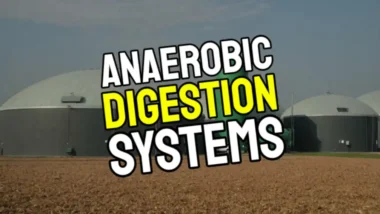The Production of Bio Methane from Biogas, Its Advantages, and Renewable Energy Options
Key Takeaways
- Bio methane, also known as renewable natural gas and simply “biomethane”, is a clean energy source derived from organic waste materials.
- Producing bio methane helps reduce greenhouse gas emissions by capturing methane that would otherwise escape into the atmosphere.
- This renewable energy source enhances energy security by reducing reliance on imported fossil fuels.
- Bio methane production supports rural economies by creating jobs and promoting sustainable agricultural practices.
- Integration of bio methane into existing energy systems can lead to significant environmental and economic benefits.
Introduction to Bio Methane as a Renewable Energy Source
Bio methane is gaining recognition as a vital component of our renewable energy future. It offers a sustainable way to generate energy while addressing some of the pressing environmental challenges we face today. By utilizing organic waste materials, bio methane production turns potential environmental hazards into valuable energy resources.
“Biomethane projects stimulate rural economies by creating jobs across the value chain, from feedstock collection to plant operations and maintenance. This not only boosts local economies but also fosters community engagement in renewable energy initiatives.”
With increasing awareness of climate change, the importance of renewable energy sources like bio methane cannot be overstated. Bio methane presents a viable solution to reduce greenhouse gas emissions, promote energy independence, and support local economies.
The Basics of Bio Methane Production
Bio methane production begins with organic matter, often referred to as biomass. This includes a variety of materials such as agricultural waste, manure, and even municipal solid waste. Through processes like anaerobic digestion or pyrolysis, these materials are converted into biogas, which primarily consists of methane and carbon dioxide.
To transform biogas into biomethane, it must undergo an upgrading process. This involves removing impurities and carbon dioxide to produce a high-quality methane gas that can be used similarly to natural gas. The result is a clean, renewable energy source that can be injected into natural gas pipelines or used as a vehicle fuel.

“Biomethane: The Future Fuel for Europe …” from www.europenowjournal.org and used with no modifications.
Environmental and Economic Significance
The environmental benefits of bio methane production are profound. By capturing methane emissions from organic waste, we can significantly reduce the amount of this potent greenhouse gas released into the atmosphere. Methane is known to be more effective at trapping heat than carbon dioxide, so mitigating its release is crucial for combating climate change. Learn more about the process of anaerobic digestion which plays a vital role in this effort.
Economically, biomethane production offers opportunities for job creation, particularly in rural areas. It supports sustainable agricultural practices by providing farmers with an additional revenue stream through the sale of waste materials. This, in turn, encourages the adoption of environmentally friendly farming techniques.
Integration with Existing Energy Systems
Integrating bio methane into existing energy systems can lead to a more resilient and sustainable energy infrastructure. Bio methane can be used to supplement traditional natural gas supplies, reducing the need for fossil fuel imports and enhancing energy security. This integration can also help stabilize energy prices by diversifying the energy supply mix.
Furthermore, bio methane can be used in various applications, from electricity generation to transportation fuels, making it a versatile and valuable component of a renewable energy portfolio.
How Bio Methane is Produced
The production of biomethane involves several key steps, starting with the collection of suitable organic materials. These materials serve as the feedstock for the production process and can include a wide range of biodegradable substances.
Source Materials for Bio Methane
Common source materials for bio methane production include:
- Agricultural residues such as crop waste and manure
- Municipal solid waste, including food scraps and yard trimmings
- Industrial waste from food processing plants
- Dedicated energy crops grown specifically for bio methane production
These materials are chosen for their high organic content, which makes them ideal for conversion into biogas.
Energy Security Enhancement
Biomethane significantly enhances energy security by diversifying the energy supply. Unlike fossil fuels, which are often imported from politically unstable regions, biomethane is produced locally. This reduces dependency on foreign energy sources and shields economies from volatile international market fluctuations. By integrating bio methane into the energy grid, we can create a more reliable and resilient energy infrastructure.
Socio-Economic Advantages
Beyond environmental benefits, bio methane production offers considerable socio-economic advantages. It creates jobs across various sectors, from feedstock collection to plant operations and maintenance. This job creation is particularly beneficial in rural areas, where employment opportunities may be limited. Moreover, the development of bio methane facilities often involves local communities, fostering a sense of ownership and engagement in renewable energy initiatives.
Additionally, biomethane projects can lead to cost savings for municipalities. By diverting organic waste from landfills to bio methane production facilities, cities can reduce waste management costs and lower landfill emissions. These savings can be redirected to other community projects, further enhancing local economic development.
Applications of Bio Methane
Bio methane's versatility makes it suitable for a wide range of applications, each contributing to a more sustainable energy future.
Use in Transportation
One of the most promising applications of bio methane is as a transportation fuel. Vehicles powered by compressed bio methane produce fewer emissions compared to those running on conventional gasoline or diesel. This makes bio methane an attractive option for reducing the carbon footprint of the transportation sector.
Industrial Applications
“Industries can benefit from using bio methane as an alternative to traditional fossil fuels. For example, a food processing plant can utilize bio methane generated from its organic waste to power its operations, thereby reducing energy costs and emissions.”
Industries that require high-temperature processes, such as cement production or metal smelting, can also use bio methane as a cleaner energy source. By replacing fossil fuels with bio methane, these industries can lower their carbon emissions and contribute to sustainability goals.
Furthermore, industries can enhance their corporate social responsibility profiles by adopting bio methane, appealing to environmentally conscious consumers and investors.
Bio methane can also be used in cogeneration systems, where it provides both electricity and heat for industrial facilities. This dual-purpose use increases energy efficiency and reduces overall fuel consumption.
Residential and Commercial Uses
In residential and commercial settings, bio methane can be used for heating and cooking. It can be injected into existing natural gas pipelines, providing a seamless transition for consumers who wish to adopt renewable energy without changing their appliances or infrastructure. This convenience makes bio methane an attractive option for homeowners and businesses looking to reduce their carbon footprint.
Bio Methane's Role in a Circular Economy
Biomethane production exemplifies the principles of a circular economy by turning waste into a valuable resource. This approach not only minimizes waste but also maximizes resource efficiency, creating a more sustainable economic model.
Waste Management and Resource Efficiency
By utilizing organic waste materials, biomethane production reduces the amount of waste sent to landfills. This not only extends the lifespan of existing landfill sites but also mitigates the release of harmful landfill gases. As a result, bio methane production plays a crucial role in improving waste management practices and enhancing environmental quality.
Partnerships Between Energy and Agriculture Sectors
Bio methane production fosters collaboration between the energy and agriculture sectors. Farmers can supply organic waste materials, such as manure and crop residues, to bio methane facilities, creating a new revenue stream. In return, bio methane facilities can provide farmers with nutrient-rich digestate, a by-product of the production process, which can be used as a natural fertilizer.
This symbiotic relationship benefits both sectors and promotes sustainable agricultural practices. It also strengthens rural economies by creating jobs and encouraging investment in renewable energy infrastructure.
- Improves nutrient recycling in agriculture
- Reduces dependency on chemical fertilizers
- Enhances soil health and productivity
Through these partnerships, biomethane production contributes to a more sustainable and resilient agricultural sector, capable of meeting the challenges of a changing climate.
Challenges and Limitations
Despite its many benefits, biomethane production faces several challenges and limitations that must be addressed to realize its full potential.
Sustainable Feedstock Supply
A reliable and sustainable supply of feedstock is essential for bio methane production. However, securing a consistent supply of organic materials can be challenging, particularly in regions with limited agricultural or industrial waste. To overcome this challenge, it is crucial to develop efficient collection and transportation systems that can deliver feedstock to biomethane facilities.
Regulatory and Infrastructure Barriers
Despite the potential benefits of bio methane, regulatory and infrastructure barriers can hinder its widespread adoption. In many regions, the regulatory framework for renewable energy is not fully developed, creating uncertainty for investors and developers. Moreover, existing infrastructure may not be compatible with bio methane, requiring significant upgrades to accommodate this renewable energy source.
Addressing these barriers requires collaboration between governments, industry stakeholders, and energy providers to establish clear regulations and invest in necessary infrastructure improvements. By creating a supportive policy environment, we can encourage the growth of biomethane production and integration into existing energy systems.

Balancing Global Demand with Local Production
As global demand for renewable energy sources like biomethane increases, it is essential to balance this demand with local production capabilities. While some regions may have abundant feedstock supplies, others may face challenges in securing enough organic materials to sustain bio methane production.
To address this issue, it is crucial to develop efficient supply chains that can transport feedstock from regions with surplus materials to areas with high demand. Additionally, investing in research and development can help identify new feedstock sources and improve production efficiency, ensuring that biomethane can meet growing global energy needs.
The Path Forward for Bio Methane
To fully realize the potential of bio methane as a renewable energy source, it is essential to adopt a comprehensive approach that addresses regulatory, technological, and economic challenges. By doing so, we can create a more sustainable and resilient energy future.
Policy Recommendations
Governments play a crucial role in promoting bio methane production through supportive policies and incentives. These can include tax credits, grants, and subsidies for bio methane projects, as well as regulations that mandate the use of renewable energy sources in specific sectors.
Furthermore, establishing clear guidelines for biomethane production and integration into existing energy systems can help reduce regulatory uncertainty and encourage investment in this renewable energy source.
Investment Opportunities
Investing in bio methane production presents numerous opportunities for both public and private stakeholders. By funding research and development, investors can drive innovation in bio methane production technologies, leading to increased efficiency and cost reductions.
Additionally, investing in infrastructure improvements can facilitate the integration of biomethane into existing energy systems, ensuring that this renewable energy source can meet growing global demand.
- Invest in research to identify new feedstock sources and improve production efficiency.
- Support infrastructure upgrades to accommodate bio methane in existing energy systems.
- Encourage public-private partnerships to drive innovation and investment in bio methane production.
By seizing these investment opportunities, stakeholders can contribute to the growth of bio methane production and help create a more sustainable energy future.
Frequently Asked Questions
As bio methane continues to gain attention as a renewable energy source, many people have questions about its production, benefits, and applications. Here, we address some of the most common inquiries.
What is the difference between biogas and bio methane?
Biogas is a mixture of gases produced during the decomposition of organic matter, primarily consisting of methane and carbon dioxide. Biomethane, on the other hand, is a purified form of biogas with the carbon dioxide and impurities removed, resulting in a high-quality methane gas suitable for use as a renewable energy source.
Can bio methane replace traditional natural gas completely?
While bio methane has the potential to supplement traditional natural gas supplies, it is unlikely to replace it entirely. However, by integrating bio methane into existing energy systems, we can reduce reliance on fossil fuels and move towards a more sustainable energy future.
What are the main challenges in producing bio methane?
Some of the main challenges in producing bio methane include securing a consistent and sustainable supply of feedstock, addressing regulatory and infrastructure barriers, and balancing global demand with local production capabilities. Overcoming these challenges requires collaboration between governments, industry stakeholders, and energy providers.
How does bio methane contribute to waste management?
Bio methane production plays a significant role in waste management by utilizing organic waste materials that would otherwise end up in landfills. By diverting these materials to bio methane facilities, we can reduce landfill emissions, improve waste management practices, and create valuable renewable energy resources.
Additionally, bio methane production generates nutrient-rich digestate, a by-product that can be used as a natural fertilizer, further enhancing waste management and resource efficiency.
What is the potential of bio methane in reducing carbon footprints?
Bio methane has significant potential to reduce carbon footprints by capturing methane emissions from organic waste and converting them into a renewable energy source. This process prevents the release of methane, a potent greenhouse gas, into the atmosphere, helping to mitigate climate change. Learn more about what biogas is and its role in renewable energy.
Furthermore, by replacing fossil fuels with bio methane, we can reduce carbon emissions in various sectors, from transportation to industry, contributing to a more sustainable and environmentally friendly energy future.
In conclusion, bio methane production offers numerous environmental, economic, and social benefits, making it a crucial component of our renewable energy future. By addressing the challenges and seizing the opportunities associated with bio methane, we can create a more sustainable and resilient energy system that benefits both people and the planet.





